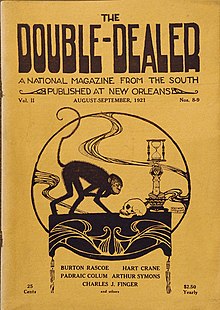The Double Dealer was a short-lived but influential New-Orleans–based literary journal of the 1920s.
 Cover of the August–September 1921 edition of The Double-Dealer | |
| Categories | Creative writing Poetry Non-fiction Fiction |
|---|---|
| Frequency | monthly |
| Founder | Julius Weis Friend (editor); Basil Thompson, Albert Goldstein, John McClure (associate editors) |
| Founded | January 1921 |
| Final issue | May 1926 |
| Country | United States |
| Based in | New Orleans, La. |
| Language | English |
Founders
editThe Double Dealer was established in 1921 as a platform for contemporary Southern writers of a modernist bent. Its founders were cultural critic Julius Weis Friend (editor) and Basil Thompson, Albert Goldstein, and John McClure (associate editors). The magazine's title came from a William Congreve play of the same name that Thompson and Friend admired for its acute dissection of human nature.[1] They saw their ideal reader as someone with a tolerant understanding of "the devious ways of the world".[2]
Loyola University New Orleans preserves the personal papers of Basil Thompson which contain correspondence, manuscripts, and other materials related to the Double Dealer.[3]
Modernism
editWith its subtitle A National Magazine for the South, The Double Dealer positioned itself to combat a popular stereotype of Southern literature as a provincial and second-rate "Sahara of the Bozart," as H.L. Mencken termed it in a notorious 1917 essay. In a piece entitled "New Orleans, the Double Dealer, and the Modern Movement in America," Sherwood Anderson laid out the editors' vision of a modernism that does not operate only at a national level but also embraces the cultural individuality of regions like the South.[4] In pursuit of its inclusive vision, The Double Dealer published African-American authors, and an unusually high proportion of its writers were women.[2]
Writers
editThe Double Dealer was published monthly from January 1921 to May 1926, during what has been called the first golden age of little magazines.[5] Described as "an incubator of local literary culture and a conduit of Modernism,"[4] it featured work by a who's who of American writers, including William Faulkner, Robert Penn Warren, Allen Tate, Amy Lowell, Ernest Hemingway, Djuna Barnes, Carl Van Vechten, Babette Deutsch, Thornton Wilder, Hart Crane, and others. The magazine was one of the first to publish Faulkner (in 1922), and editor John McClure remained a Faulkner friend and sponsor for years after the magazine folded.[6] Although it only lasted five years, The Double Dealer influenced a number of later journals that took up the cause of championing Southern literature: The New Orleanian (established 1930), The Southern Review (est. 1935), Iconograph (est. 1940), and Double Dealer Redux (est. 1993 and published by the Faulkner Society).[2]
References
edit- ^ Bowen, Frances Jean. "The New Orleans Double Dealer, 1921-26." Louisiana Historical Quarterly 39 (1956): 443-56.
- ^ a b c "KnowLA: Encyclopedia of Louisiana". Retrieved 7 October 2014.
- ^ "Basil Thompson Papers Finding Aid" (PDF). Special Collections & Archives, J. Edgar & Louise S. Monroe Library, Loyola University New Orleans. Retrieved 17 July 2018.
- ^ a b Kennedy, Richard S., ed. Literary New Orleans in the Modern World. LSU Press, 2006.
- ^ Weddle, Jeff. Bohemian New Orleans: The Story of the Outsider and Loujon Press. University of Mississippi Press, 2007.
- ^ Faulkner, William. New Orleans Sketches. Carvel Collins, ed. University of Mississippi Press, 2010.
Further reading
edit- McKinney, Louise. New Orleans: A Cultural History. Oxford University Press, 2006.
- Watson, James G. "New Orleans, The Double Dealer, and 'New Orleans'." American Literature, 1984, pp. 214–226.